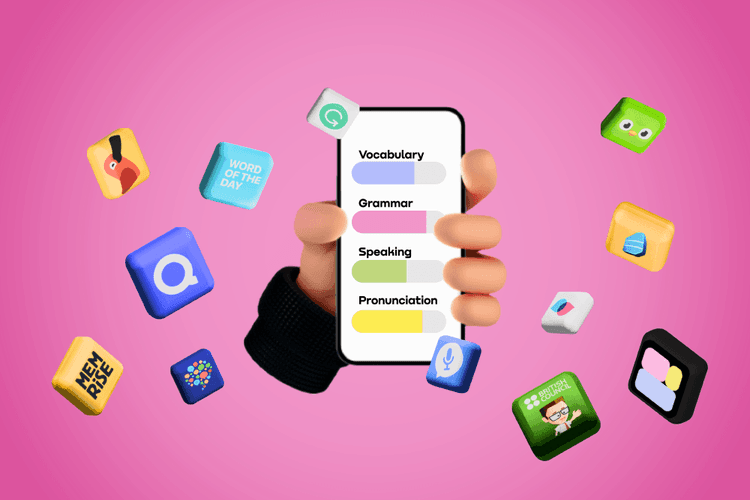Gamified Language Learning Apps: Helping or Hurting Your Progress?

Contents
Key takeaways:
- AI gamification in language learning has several pros and cons.
- The benefits of gamified language learning apps include instant feedback, higher motivation, and more learner engagement.
- The downsides of these apps are that they’re often too easy or distracting and can lead to lower retention and even addiction.
These days, gamified language learning apps are often considered to as the top language learning resource. When thinking of picking up a new language, most people’s first thought is using Duolingo or a similar app. But is AI gamification actually good for you? Or is it hurting your progress?
In this article, we’re going to answer these questions and take a look at the benefits and the downsides of gamification in language learning.
What is gamification in language learning?
Before the 2010s, most language learning was done through traditional methods. Some online platforms were slowly incorporating gamification, but for the most part, if you wanted to learn English, you’d sign up for an English class, hire a tutor, or at least buy a textbook and try to follow it.
However, this all changed in the early 2010s. The popular app Duolingo was launched in the summer of 2012, and since then, more and more users have turned to gamified language learning apps.
These apps use elements of video gaming to engage their users. Learners can improve their language skills while basically playing a simple game. The apps are interactive, with quick lessons to compensate for their users’ potentially short attention spans. They also offer features such as progress tracking, friend challenges, and more.
AI technology has also played a big role in promoting gamification in language learning. Now, learners can get instant personalized feedback and even practice speaking with an AI language assistant.
Gamified language learning apps: pros and cons
| Pros and Cons of Gamified Language Learning Apps | |
| Pros | Cons |
| More engagement | Lower retention |
| Instant feedback | Too easy |
| Higher motivation | Too distracting |
| Active participation | Potentially addictive |
 AI gamification in language learning is pretty much everywhere. Teachers use it in their classrooms, and there are countless articles recommending all kinds of online tools. But when it comes to gamified language learning apps in particular, you have to wonder: Are they actually useful? Or are they just popular because they provide meaningless instant gratification?
AI gamification in language learning is pretty much everywhere. Teachers use it in their classrooms, and there are countless articles recommending all kinds of online tools. But when it comes to gamified language learning apps in particular, you have to wonder: Are they actually useful? Or are they just popular because they provide meaningless instant gratification?
What are the benefits of gamification in language learning?
While some people may be doubtful about the usefulness of gamified language learning apps, there’s no denying that there are many benefits to learning a language this way. These include:
- More engagement: Compared to traditional methods, which many would describe as tedious, language learning apps make learning fun. They’re interactive, innovative, and engaging. Everyone loves to play, and these apps know that. They turn learning into entertainment, and it works.
- Instant feedback: One benefit of AI-powered language learning is that there is no necessary waiting time. In a classroom environment, students often have to wait for their teachers to mark their tests. But with apps, the feedback is instant and, thanks to AI, it’s also personalized to each user.
- Higher motivation: Gamified language learning apps often include challenges, badges, progress trackers, and more. They make continuous learning satisfying and feed into their users’ natural competitiveness. This makes learning much more rewarding and motivating.
- Active participation: In a traditional classroom, students are often asked to sit and listen. Even when they’re encouraged to speak, not everyone has to get involved. Language learning apps are different. Each person does them individually. They also often involve puzzles and stories, which makes the users interact with their target language more actively.
7
What are the hidden risks of gamification?
Now that you know the benefits of AI gamification in language learning, it’s time to look at the downsides of these apps. There are several risks you should keep in mind:
- Lower retention: Many of these apps offer quick 2-5 minute lessons. When combined with irregular sessions, it’s easy for students to quickly forget what they learned.
- Too easy: Because the draw of gamified language learning apps is how satisfying they are, the exercises are often not made to be super challenging. This would prevent users from gaining badges and winning challenges, which may turn them off using the app. However, due to the questions often being on the easy side, learners don’t have to think as much, meaning that they likely learn a lot less than they would in a traditional classroom.
- Too distracting: Some learners get so invested in their progress streak and leaderboard placement that they forget about the language they’re learning. They focus on the gamification aspect instead, which, according to studies, negatively affects their learning journey.
- Potentially addictive: Language learning apps often use video game features. Unfortunately, video games can be addictive and can lead to the so-called gaming disorder. The same could potentially happen with gamified language learning apps.
How AI gamification impacts motivation and retention
Motivation and retention are two of the biggest concerns when it comes to language learning. These days, thanks to apps such as TikTok, people tend to have shorter attention spans. This can make finding the motivation to learn a new language difficult. Language learning is a long journey, and you need to put in hundreds or even thousands of hours to achieve fluency.
Due to the instant gratification nature of gamified language learning apps, using apps can actually help learners stay more motivated. Similarly, progress trackers, award badges, and XP (experience points) boosters can make students feel more excited to learn.
Unfortunately, this motivation is quite fickle. If a user has to miss a day due to personal reasons and loses their 300-day streak, they might start feeling demotivated instead. The drive to keep going may disappear due to their disappointment, and they might even abandon language learning entirely.
Retention is also a potential issue with AI gamification. Language learning apps promote short lessons and often tell their users that they’re doing a good job. As a result, many opt to only do the bare minimum, which is often not enough to make genuine progress and retain the new material being taught.
But does this mean that students can’t learn anything substantial just by using gamified language learning apps? Not quite.
How to use gamified apps effectively
| How to Get the Most Out of Language Learning Apps | |
| 1. Use the apps consistently. | 4. Diversify your lessons. |
| 2. Revise what you learned. | 5. Choose the right app. |
| 3. Connect with other learners. | 6. Don’t rely solely on apps (use other resources). |
 One of the biggest issues with gamification in language learning is that it isn’t used correctly. Students need to put in effort and use these apps intentionally to see real progress. If you’re unsure how to do this, here are some useful tips that will make your language learning process more effective:
One of the biggest issues with gamification in language learning is that it isn’t used correctly. Students need to put in effort and use these apps intentionally to see real progress. If you’re unsure how to do this, here are some useful tips that will make your language learning process more effective:
- Use the apps consistently: To see real progress, consistency is key. Try to do at least one lesson a day, or set up a weekly schedule.
- Revise what you learned: Revision is another key aspect of language learning. Go back to past lessons periodically to refresh your memory.
- Connect with other learners: Often, these apps let you add friends or join community forums. Take advantage of this and interact with people learning the same language as you. This can help you stay motivated, and you may even be able to address any concerns or questions that might come up with the help of the other users.
- Diversify your lessons: Don’t just stick to one type of game (e.g., vocabulary drill). Try to practice a little bit of everything, including reading, writing, listening, and grammar.
- Choose the right app: Don’t just download the most popular app. Think about your learning style and preferences, and look up what apps are out there. Consider which ones best fit what you like. And don’t forget to look up reviews!
- Don’t rely solely on apps: Combine them with other learning resources and methods, such as podcasts, textbooks, flashcards, and more.
For even more tips on how to use gamified language learning apps and what mistakes to avoid, watch this helpful YouTube video:
Promova — your buddy in smart language learning
If you’re learning English and are looking for an easy-to-use, innovative language learning app, try Promova! Our app is suitable for both beginner and advanced learners, as well as anyone in between. With features such as interactive daily lessons, an AI speaking assistant, and regular quizzes, you’ll see progress in no time.
And if you prefer teacher-led courses? We offer those, too. Try our online English speaking course today and impress your friends and coworkers with your fluency.
Final thoughts
Gamified language learning apps have many pros and cons. They’re great at keeping their users motivated and engaged, and they often make learning fun. However, they can also lead to lower retention due to their ease and distracting nature.
To get the most out of these apps and see genuine progress, use them intentionally and don’t solely rely on them. Combine them with other learning resources to get closer to fluency.
FAQ
What are gamified language learning apps?
Gamified language learning apps are apps that use video game features to teach their users their target language.
Some examples of these apps are Duolingo, Memrise, Promova, Babbel, and more. Thanks to language learning apps, many learners find language learning fun and engaging, which leads to higher motivation and more active engagement.
However, the apps also have some downsides, including lessons that are too easy, a distracting interface, and more.
What are the best free gamification tools for language learning?
Some of the most useful free tools include apps like Promova (which combines challenges, achievements, AI practice, live tutors, and a free conversation club), Duolingo, and Memrise. Digital flashcards like Anki and Quizlet, board games like Scrabble, and language challenges on social media also help make learning fun and engaging.
Promova stands out because it mixes gamification with real conversation practice, a key factor for building confidence when speaking.
How to gamify language learning?
To gamify language learning, consider implementing a point system, progress trackers, and interactive experiences.
If you’re a language teacher, you can do this in your class. For example, ask your students to write down as many words on a certain topic as possible. Whoever has the most unique words gains a point. The person with the most points at the end of the semester wins.
Can you learn a language with gamification alone?
It is possible to learn a language with gamified language learning apps alone, but only to a certain degree. Most apps don’t go from A1 to all the way to the C2 level, so you likely won’t be able to achieve native-like fluency through AI gamification alone.
However, they are still a good place to start and can provide a solid base which you can later build upon with other language learning resources.



Comments